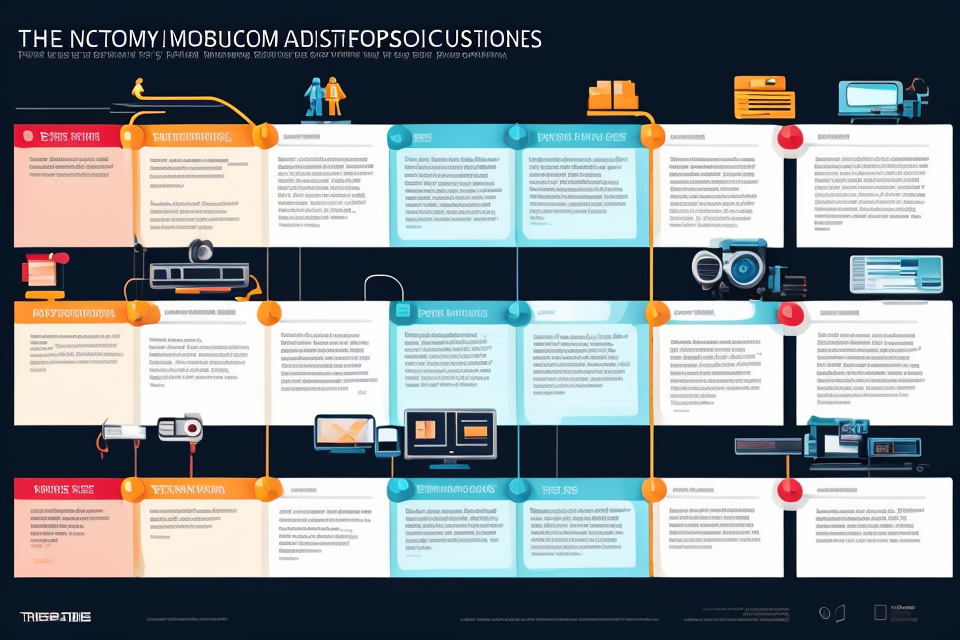The term ‘digital transformation’ has become a buzzword in recent years, but few know its roots. The evolution of digital transformation has been a gradual process, shaped by the rapid advancements in technology and the ever-changing demands of society. From the early days of computing to the current era of artificial intelligence, this journey has been marked by numerous milestones and breakthroughs. In this article, we will delve into the historical overview of digital transformation, exploring its origins and how it has evolved over time. So, let’s embark on a journey through the ages and discover the forces that have shaped the digital world as we know it today.
The Emergence of Digital Technologies
The Rise of Computers
The advent of computers marked a significant turning point in the history of digital transformation. In the early 1940s, the first electronic computers were developed, ushering in a new era of computing. These machines were enormous and cumbersome, but they represented a significant step forward in the development of digital technology.
The First Electronic Computers
The first electronic computers were built during World War II, primarily for the purpose of solving complex mathematical problems. These machines were the size of entire rooms and required teams of people to operate them. However, they were significantly faster and more accurate than their mechanical or electro-mechanical predecessors.
The Electronic Numerical Integrator and Computer (ENIAC) was one of the earliest examples of an electronic computer. Completed in 1945, it was capable of performing calculations at a rate of 2,000 per second, which was a remarkable achievement at the time. ENIAC was not the first electronic computer, but it was the first to be built using electronic valves, which made it much faster and more reliable than earlier machines.
The Mainframe Era
In the years following the development of the first electronic computers, mainframe computers became the dominant form of computing technology. Mainframe computers were enormous, centralized machines that were capable of processing vast amounts of data. They were used by governments, universities, and businesses to perform complex calculations and process large amounts of data.
During the mainframe era, computing was largely centralized, with organizations relying on large mainframe computers to perform all of their computing needs. This meant that computing resources were expensive and difficult to access, limiting the growth of digital technology.
Despite these challenges, the mainframe era laid the foundation for the modern computing industry. Mainframe computers paved the way for the development of smaller, more affordable computing devices, such as personal computers and smartphones, which would later become ubiquitous in our daily lives.
The Birth of the Internet
ARPANET and the First Websites
The birth of the internet can be traced back to the late 1960s, when the United States Department of Defense commissioned a project to create a network that could withstand a nuclear attack. This project, known as ARPANET (Advanced Research Projects Agency Network), was the first wide-area network to use packet switching technology, which allowed data to be transmitted across multiple computers and networks.
ARPANET was initially designed to connect researchers and scientists across different universities and laboratories, enabling them to share information and collaborate on research projects. However, the network soon evolved beyond its original purpose, and by the 1980s, it had become a vital tool for communication and information sharing.
The Emergence of the World Wide Web
The emergence of the World Wide Web in the mid-1990s revolutionized the way people accessed and shared information over the internet. The Web was created by Sir Tim Berners-Lee, a British computer scientist who worked at CERN (European Organization for Nuclear Research) in Switzerland. Berners-Lee developed the first web browser and web server, which allowed users to easily access and navigate web pages.
The World Wide Web transformed the internet from a simple network for information sharing to a global platform for communication, commerce, and entertainment. It made it possible for individuals and organizations to publish and access information from anywhere in the world, leading to the creation of a new digital economy.
The proliferation of the World Wide Web also led to the development of new technologies and platforms, such as search engines, social media, and e-commerce sites, which have had a profound impact on society and the economy. Today, the internet is an integral part of everyday life, and its impact on business, culture, and society continues to grow.
Digital Transformation in the Business World
Early Adoption and Innovation
Companies Embracing Digital Technologies
In the early stages of digital transformation, companies began to adopt digital technologies as a means of improving their operations and gaining a competitive advantage. These companies recognized the potential of digital technologies to streamline processes, reduce costs, and increase efficiency.
Some of the earliest adopters of digital technologies were in the banking and finance sectors. Banks began to use digital technologies to automate processes, such as loan applications and account management, which helped to reduce costs and improve customer service. In the finance sector, digital technologies were used to improve trading and investment processes, making them faster and more efficient.
Disruptive Innovations and Business Models
As digital technologies continued to evolve, they began to disrupt traditional business models. Companies that had previously relied on traditional methods of operation were forced to adapt to the new digital landscape or risk being left behind.
One of the most significant disruptions came in the form of e-commerce. Online retailers began to emerge in the 1990s, offering customers a more convenient and cost-effective way to shop. This disrupted traditional brick-and-mortar retailers, who were forced to adapt to the new digital landscape or risk losing market share.
Another area where digital technologies had a significant impact was in the media industry. The rise of the internet and social media led to a decline in traditional print media, as readers turned to online sources for their news and information. This forced media companies to adapt to the new digital landscape or risk losing readers and advertising revenue.
Overall, the early adoption of digital technologies in the business world was characterized by a willingness to embrace new technologies and adapt to the changing landscape. Companies that were able to successfully navigate this transition were able to gain a competitive advantage and thrive in the digital age.
The Digital Revolution in the 21st Century
The 21st century has witnessed a profound transformation in the business world, as digital technologies have reshaped the way companies operate and compete. The emergence of new technologies and trends has enabled businesses to reimagine their operations, processes, and customer experiences, ultimately leading to the development of digital transformation strategies. In this section, we will explore some of the key developments that have driven the digital revolution in the 21st century.
The Advent of Cloud Computing
One of the most significant developments in the 21st century has been the rise of cloud computing. Cloud computing refers to the delivery of computing services over the internet, including storage, software, and processing power. This technology has enabled businesses to access and use technology resources on-demand, without the need for expensive hardware or infrastructure. Cloud computing has also facilitated greater collaboration and remote work, enabling businesses to operate more efficiently and effectively.
The Internet of Things (IoT) and Big Data
Another critical development in the 21st century has been the rise of the Internet of Things (IoT). IoT refers to the network of physical devices, vehicles, home appliances, and other items embedded with electronics, software, sensors, and connectivity which enables these objects to connect and exchange data. The proliferation of IoT devices has generated vast amounts of data, known as Big Data, which has the potential to transform the way businesses operate. By analyzing and leveraging Big Data, businesses can gain valuable insights into customer behavior, preferences, and needs, enabling them to create more personalized and targeted marketing campaigns, improve product development, and optimize operations.
In conclusion, the digital revolution in the 21st century has been driven by the emergence of cloud computing and the Internet of Things, which have enabled businesses to operate more efficiently, effectively, and data-driven. These technologies have been critical in the development of digital transformation strategies, as businesses seek to remain competitive and adapt to the rapidly changing digital landscape.
Digital Transformation in Society
The Impact on Individuals and Communities
The Changing Nature of Work
The digital transformation has significantly altered the nature of work in recent years. With the rise of remote work and digital collaboration tools, employees now have more flexibility in terms of where and when they work. This has enabled people to balance their professional and personal lives more effectively, as they can now work from home or from anywhere in the world. Additionally, the use of automation and artificial intelligence has changed the skills required for certain jobs, with a growing demand for workers who can operate and maintain these technologies.
The Proliferation of Social Media and E-Commerce
The digital transformation has also had a profound impact on social media and e-commerce. Social media platforms have become integral to how people communicate and connect with one another, allowing individuals to share their thoughts, ideas, and experiences with a global audience. This has enabled people to build and maintain relationships with others who may be physically far away, as well as to access a wealth of information and resources.
In terms of e-commerce, the digital transformation has made it easier for businesses to reach customers and for customers to access products and services. Online marketplaces and e-commerce platforms have proliferated, providing individuals with a wide range of options for purchasing goods and services. This has also enabled small and medium-sized enterprises to compete with larger corporations, as they can now reach a global audience without the need for a physical storefront.
However, the digital transformation has also had its challenges, particularly for individuals and communities who may not have access to the necessary technology or digital skills. These individuals may struggle to keep up with the pace of change, leading to potential social and economic inequalities. As such, it is important for policymakers and business leaders to ensure that the digital transformation is inclusive and equitable, so that all individuals and communities can benefit from the opportunities it presents.
The Future of Digital Transformation
Ongoing Technological Advancements
As digital transformation continues to evolve, we can expect ongoing technological advancements that will further shape the future of this revolution. These advancements will be driven by emerging technologies such as artificial intelligence, machine learning, the Internet of Things, and 5G networks.
- Artificial Intelligence: AI will play a crucial role in digital transformation by enabling businesses to automate processes, make data-driven decisions, and provide personalized customer experiences. AI-powered chatbots, virtual assistants, and intelligent automation systems will become increasingly common in the workplace, transforming the way we work and collaborate.
- Machine Learning: ML will enable businesses to analyze vast amounts of data and make predictions about future trends and behaviors. This will enable companies to optimize their operations, identify new opportunities, and create more personalized experiences for their customers.
- Internet of Things: IoT devices will continue to proliferate, connecting everything from our homes to our cars to our workplaces. This will enable businesses to collect real-time data on their operations and customers, providing insights that can be used to optimize processes and create new products and services.
- 5G Networks: The rollout of 5G networks will bring faster speeds, lower latency, and increased capacity, enabling businesses to connect more devices and transfer larger amounts of data. This will support the growth of emerging technologies such as autonomous vehicles, smart cities, and augmented reality.
Emerging Trends and Opportunities
As digital transformation continues to evolve, we can expect to see new trends and opportunities emerge. These trends will be driven by changing consumer behaviors, new technologies, and shifts in the global economy.
- Augmented Reality: AR will become increasingly important in digital transformation, enabling businesses to create immersive experiences that blend the digital and physical worlds. AR will be used in retail, marketing, and education, among other industries, providing new ways for businesses to engage with customers and employees.
- Blockchain: Blockchain technology will play an important role in digital transformation, enabling secure and transparent transactions and data sharing. This will be particularly important in industries such as finance, healthcare, and supply chain management, where secure and reliable data sharing is critical.
- Remote Work: The COVID-19 pandemic has accelerated the trend towards remote work, and this is likely to continue in the future. Digital transformation will play a crucial role in enabling remote work, providing tools and technologies that allow employees to collaborate and communicate effectively from anywhere in the world.
- Sustainability: As concerns about climate change and sustainability continue to grow, digital transformation will play an important role in enabling businesses to reduce their environmental impact. This will include the use of renewable energy, sustainable supply chains, and circular economy principles, among other initiatives.
Overall, the future of digital transformation is likely to be characterized by ongoing technological advancements and the emergence of new trends and opportunities. As businesses continue to adapt to these changes, they will need to focus on creating innovative products and services, improving customer experiences, and driving operational efficiency. By embracing digital transformation, businesses can position themselves for long-term success in a rapidly changing world.
FAQs
1. What is digital transformation?
Digital transformation refers to the integration of digital technology into all areas of a business, resulting in fundamental changes to how the business operates and delivers value to its customers. It involves the use of digital tools, processes, and technologies to optimize operations, enhance customer experience, and improve decision-making.
2. When did digital transformation begin?
The concept of digital transformation can be traced back to the 1960s when computers were first introduced to businesses. However, it wasn’t until the widespread adoption of the internet in the 1990s that digital transformation began to take off. The rise of e-commerce, online banking, and other digital services paved the way for more extensive use of digital technology in various industries.
3. What are some of the key drivers of digital transformation?
There are several factors that have driven the adoption of digital transformation, including the need for greater efficiency and productivity, the desire to enhance customer experience, and the rise of new technologies such as cloud computing, artificial intelligence, and the Internet of Things. Additionally, changing customer expectations and the need to stay competitive in a rapidly evolving business landscape have also played a significant role in the growth of digital transformation.
4. How has digital transformation evolved over time?
Digital transformation has undergone significant changes since its inception. In the early days, it was primarily focused on automating manual processes and reducing costs. However, as technology has advanced and become more accessible, the focus has shifted towards improving customer experience, enhancing innovation, and driving growth. Today, digital transformation is a strategic imperative for businesses across all industries, as it offers the potential to unlock new opportunities and create competitive advantages.
5. What are some examples of successful digital transformation?
There are many examples of successful digital transformation across various industries. For instance, Netflix transformed from a DVD rental service to a leading streaming platform, Uber disrupted the transportation industry with its digital platform, and Amazon has revolutionized e-commerce and become one of the world’s most valuable companies. Other examples include Airbnb, which has transformed the hospitality industry, and Tesla, which has revolutionized the automotive industry with its electric vehicles and renewable energy solutions.
6. What challenges have businesses faced during digital transformation?
Digital transformation is not without its challenges. Businesses have faced difficulties in areas such as culture change, talent acquisition, and integration of new technologies. Resistance to change, lack of investment, and inadequate planning have also been significant obstacles. To overcome these challenges, businesses need to develop a clear strategy, involve employees in the transformation process, and ensure that they have the necessary skills and resources to support the change.
7. What is the future of digital transformation?
The future of digital transformation is likely to be shaped by emerging technologies such as artificial intelligence, blockchain, and 5G. These technologies have the potential to transform industries and create new business models. Additionally, the increasing use of data analytics and the Internet of Things will drive further innovation and enable businesses to become more agile, efficient, and customer-centric. As digital transformation continues to evolve, businesses that embrace it will be better positioned to compete and succeed in the future.



